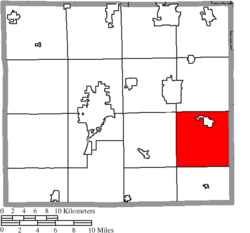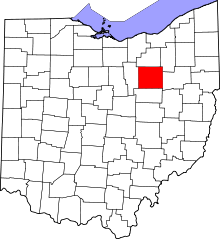Sugar Creek Township, Wayne County, Ohio
| Sugar Creek Township, Wayne County, Ohio | |
|---|---|
| Township | |
|
Commercial district in Kidron | |
 Location of Sugar Creek Township in Wayne County | |
| Coordinates: 40°46′46″N 81°42′38″W / 40.77944°N 81.71056°WCoordinates: 40°46′46″N 81°42′38″W / 40.77944°N 81.71056°W | |
| Country | United States |
| State | Ohio |
| County | Wayne |
| Area | |
| • Total | 37.3 sq mi (96.6 km2) |
| • Land | 37.3 sq mi (96.5 km2) |
| • Water | 0.0 sq mi (0.1 km2) |
| Elevation[1] | 1,119 ft (341 m) |
| Population (2000) | |
| • Total | 6,502 |
| • Density | 174.4/sq mi (67.4/km2) |
| Time zone | Eastern (EST) (UTC-5) |
| • Summer (DST) | EDT (UTC-4) |
| FIPS code | 39-75231[2] |
| GNIS feature ID | 1087161[1] |
Sugar Creek Township is one of the sixteen townships of Wayne County, Ohio, United States. The 2000 census found 6,502 people in the township, 4,897 of whom lived in the unincorporated portions of the township.[3]
Geography
Located in the eastern part of the county, it borders the following townships:
- Baughman Township - north
- Tuscarawas Township, Stark County - east
- Sugar Creek Township, Stark County - southeast
- Paint Township - south
- Salt Creek Township - southwest corner
- Green Township - northwest corner
- East Union Township - west
The village of Dalton is located in northern Sugar Creek Township, and the unincorporated community of Kidron lies in the southwestern part of the township.
Name and history
It is one of five Sugar Creek Townships statewide.[4]
Like the founders of Kidron, the early settlers of Sugar Creek came from the canton of Bern in Switzerland. The settlers of Sugar Creek, however, arrived probably a decade or two later than their Kidron neighbors in the 1830s and 1840s, and were part of the Reformed Church not Mennonite. Sugar Creek had its post office established in 1888, when it received its official name. Sugar Creek was originally named for a local stream running nearby, and the small settlement of Shanesville later merged with Sugar Creek.[5]
Government
The township is governed by a three-member board of trustees, who are elected in November of odd-numbered years to a four-year term beginning on the following January 1. Two are elected in the year after the presidential election and one is elected in the year before it. There is also an elected township fiscal officer,[6] who serves a four-year term beginning on April 1 of the year after the election, which is held in November of the year before the presidential election. Vacancies in the fiscal officership or on the board of trustees are filled by the remaining trustees.
References
- 1 2 "US Board on Geographic Names". United States Geological Survey. 2007-10-25. Retrieved 2008-01-31.
- ↑ "American FactFinder". United States Census Bureau. Retrieved 2008-01-31.
- ↑ Wayne County, Ohio — Population by Places Estimates Ohio State University, 2007. Accessed 15 May 2007.
- ↑ "Detailed map of Ohio" (PDF). United States Census Bureau. 2000. Retrieved 2007-02-16.
- ↑ A Little Bit Swiss: Amish Country's "other" heritage, Amish-Heartland.com. 2002-09-30. Accessed 2009-04-26.
- ↑ §503.24, §505.01, and §507.01 of the Ohio Revised Code. Accessed 4/30/2009.

